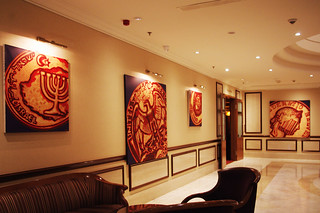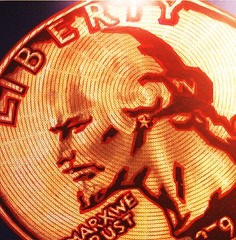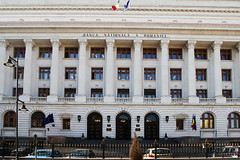
PREV ARTICLE
NEXT ARTICLE
FULL ISSUE
PREV FULL ISSUE
HOWARD BERLIN VISITS BUCHAREST, ROMANIA
Numismatourist Howard Berlin submitted this report on his recent visit to Bucharest, Romania. Thanks! -Editor
Following my visit to Riga and another overnight stay in Berlin, I landed in Bucharest - the country of Vlad III, Prince of Wallachia (aka Vlad the Impaler), who the world knows as Dracula. He was a member of the House of Drăculești, from which the Anglicized Dracula name evolved. As was told to me by my hotel’s concierge, Vlad III was the “founder” of Bucharest, first establishing his residence here. With my first visit to Romania, I have now been to 58 countries. Wayne Homren already let the cat out of the bag, so to speak, by including my photo of the “blood bank” – the Banca Transilvania, at the airport in a recent issue of The E-Sylum. The bank is Romania’s third largest in terms of deposits. Although a member of the EU, Romania is not part of the eurozone and still uses the leu (lei, plural) as its currency, now featuring plastic polymer notes since 2005. Museums in Europe are generally closed on Mondays, but I had to fit most of my intended museum visits into one day (Sunday) as all municipal and state museums are closed on both Mondays and Tuesdays and I was leaving for London Wednesday morning. Fortunately for me, there were a few exceptions. One of these, although not of numismatic interest, is perhaps Bucharest’s most popular tourist attraction (if not of all of Romania) is the People’s Palace (aka the Palace of Parliament). It is the world's largest civilian building with an administrative function and is the second largest building in the world after the Pentagon in Washington, D.C. It was ordered built by Romanian Commie dictator Nicolae Ceausescu at a staggering cost of 3 billion euros. It was initiated in 1986 as a monument to the excesses of Ceausescu and his wife’s lavish lifestyle, which just about bankrupted the country. The palace has 12 floors and 1,100 rooms, but there is no mention of how many bathrooms there are. Following protests and the shooting of some of the demonstrators in the Western part of the country, Ceausescu and his wife Elena were captured trying to flee the city and were quickly tried and executed on Christmas day 1989 while the palace was still under construction. The new government thought about stopping construction and demolishing it but found this would have cost just as much as it was to build it. Sometimes I find numismatic-related items in unexpected places. In my hotel’s lobby (the Athénée Palace Hilton Bucharest) where the restaurant (Roberto’s) and the English Bar (apparently this was the preferred spot for spies during World War II) are located, on the walls are satirical renditions of U.S. and other foreign coins.  
The primary numismatic exhibition here is the National Bank of Romania Museum, the country’s central bank. You need to arrange for an appointment to tour the museum at least three days in advance, and providing passport information, if you decide on visiting it. My hotel’s trusty concierge talked to someone at the Bank and was able to get me an appointment the day before I was to leave.
After clearing security, I was escorted on a tour of the museum by Ms. Ruxandra Onofrei who explained the history of the bank and the building we were in. I was allowed to photograph anything that was on display with the exception of one room which was entered through a bank vault-like door. In this room was a display of several gold ingots (looked like approximately 12 kg each) from the former Soviet Union, Switzerland, and the U.S. along with historical information panels on the walls. 

Virtually the entire exhibition on the ground and second floors is spread out and uncluttered, with lots of space around the display cases. With text in both Romanian and English, displays feature money in use in Romania throughout history. Exhibited specimens included items, such as arrowheads, used as barter in ancient Romania (6-5th century BC); coins from Greece and Macedonia (4th-1st century BC); Koson (Transylvania) gold coins with a simple monogram (1st century BC); Roman Republic coins (2nd-1st century BC); Imperial Roman coins (1st-3rd century AD); late Roman coins (4th-5th century); Byzantine coins (6th-13th century); coins issued in the Romanian country (14th-18th century); coins issued in Moldova (14th-17th century); gold coins issued in the Romanian country (16th-17th century); Russian coins of Sadagura (18th century); coins issued in Transylvania (16th-18th century); Foreign coins that circulated in Romania (13th-19th century), which included an 1881 Morgan dollar and an 1898 gold double eagle; and 18th century silver and bronze coins from the Ottoman Empire, Austria, German States, Russia, France, Spain, and Netherlands. In an area by itself, is an exhibit illustrating the history of Romanian currency (coins and banknotes). To read the earlier E-Sylum article, see:
Wayne Homren, Editor The Numismatic Bibliomania Society is a non-profit organization promoting numismatic literature. See our web site at coinbooks.org. To submit items for publication in The E-Sylum, write to the Editor at this address: whomren@gmail.com To subscribe go to: https://my.binhost.com/lists/listinfo/esylum All Rights Reserved. NBS Home Page Contact the NBS webmaster 
|
